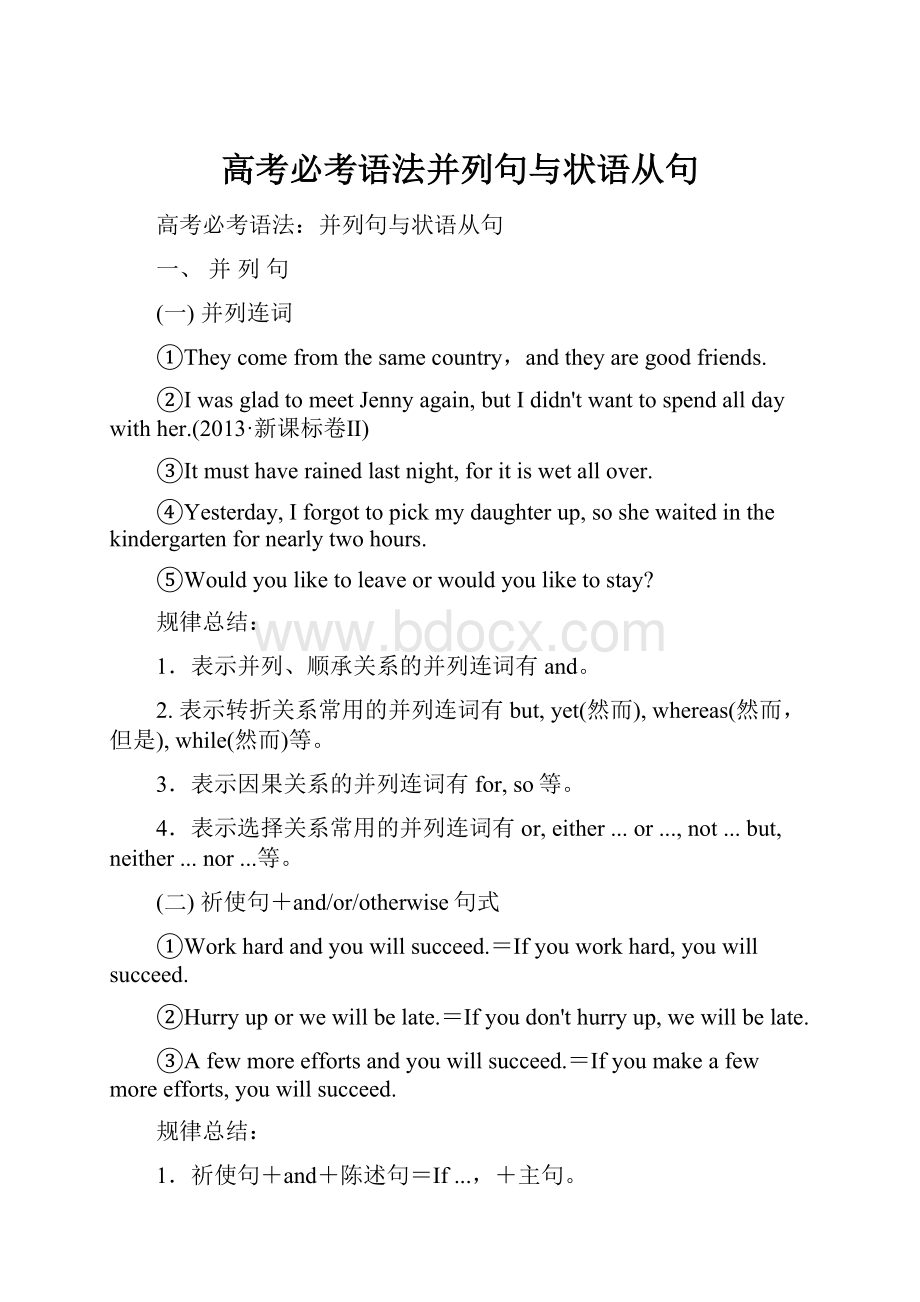 高考必考语法并列句与状语从句.docx
高考必考语法并列句与状语从句.docx
- 文档编号:24694431
- 上传时间:2023-05-31
- 格式:DOCX
- 页数:16
- 大小:24.94KB
高考必考语法并列句与状语从句.docx
《高考必考语法并列句与状语从句.docx》由会员分享,可在线阅读,更多相关《高考必考语法并列句与状语从句.docx(16页珍藏版)》请在冰豆网上搜索。

高考必考语法并列句与状语从句
高考必考语法:
并列句与状语从句
一、并列句
(一)并列连词
①Theycomefromthesamecountry,and theyaregoodfriends.
②IwasgladtomeetJennyagain, but Ididn'twanttospendalldaywithher.(2013·新课标卷Ⅱ)
③Itmusthaverainedlastnight, for itiswetallover.
④Yesterday,Iforgottopickmydaughterup, so shewaitedinthekindergartenfornearlytwohours.
⑤Wouldyouliketoleave or wouldyouliketostay?
规律总结:
1.表示并列、顺承关系的并列连词有and。
2.表示转折关系常用的并列连词有but,yet(然而),whereas(然而,但是),while(然而)等。
3.表示因果关系的并列连词有for,so等。
4.表示选择关系常用的并列连词有or,either...or...,not...but,neither...nor...等。
(二)祈使句+and/or/otherwise句式
①Workhard and youwillsucceed.=If youworkhard,youwillsucceed.
②Hurryup or wewillbelate.=If you don't hurryup,wewillbelate.
③Afewmoreefforts and youwillsucceed.=Ifyoumakeafewmoreefforts,youwillsucceed.
规律总结:
1.祈使句+and+陈述句=If...,+主句。
2.祈使句+or/otherwise+陈述句=If...not...,+主句。
二、状语从句
英语中状语从句总共有九类,分别用来表示时间、地点、原因、目的、结果、条件、方式、比较、让步等。
状语从句是较复杂的语法项目,但是理解起来并不难。
从本质上讲,状语从句就是利用不同的关联词语将几个分句连接起来,以表达分句之间的特定逻辑关系。
例如:
①Ihavebroughtanumbrellabecauseitisraining.(原因)
②Ihavebroughtanumbrellaincaseitrains.(目的)
③IhavebroughtanumbrellasothatIdon'tgetwet.(结果)
④Ihavebroughtanumbrellaeventhoughit'snotraining.(让步)
⑤Youdon'tneedbringanumbrellaunlessitisraining.(条件)
因此,学习状语从句的关键是掌握引导九类状语从句的关联词,只要能记住关联词,一般都能识别是哪种状语从句,从而正确分析句子结构并理解句子意思。
下面分别对九大类别的状语从句进行举例说明:
(一)时间状语从句 时间状语从句表示时间。
引导时间的状语从句的常用引导词有:
when,as,while,assoonas,while,before,after,since,till,until等。
特殊引导词有:
theminute,themoment,thesecond,everytime,theday,theinstant,immediately,directly,nosooner…than,hardly…when,scarcely…when等。
1.when/while/as/whenever
①WhenIwentintotheoffice,theteacherswerehavingameeting.
②WhileIwasdoingmyhomework,theycamein.
③Astimegoesby,it'sgettingwarmerandwarmer.
④When/While/AsIwaswalkingdownthestreet,Icameacrossanoldfriendofmine.
⑤Weshallgotherewheneverwearefree.
规律总结:
(1)when既可引导一个持续动作,也可引导一个短暂动作,可用于主句和从句动作同时发生或从句动作先于主句动作。
(2)从属连词while引导的动作必须是持续性的,侧重主句动作和从句动作相对比。
(3)从属连词as可表示从句和主句的两个动作交替进行或同时完成,可译为"一边……(,一边……)"或"随着……"。
(4)如果主句表示的是短暂性动作,而从句用延续性动词的进行时态表示在一段时间内正在进行的动作,此时when,while与as可互换使用。
(5)whenever是when的强势语,它描述的不是一次性动作,而是经常发生的习惯性动作,翻译成"无论何时"。
2.when的特殊用法
①He wasaboutto gotobed when thedoorbellrang.
②They werewatching theWorldCup when suddenlythelightswentout.
③They hadjustarrived home when itbegantorain.
规律总结:
when引导时间状语从句,意为"正在这时",表示某件事正要发生、正在发生或刚刚发生时,突然发生另一动作。
常见句型有:
①was/wereabouttodosth.when...
=was/wereonthepointofdoingsth.when...
②was/weredoingsth.when...
③had(just)donesth.when...
3.表示"刚……就……,一……就……"的常用表达
①Themoment Iheardthevoice,Iknewfatherwascoming
②Theboyburstintotears immediately hesawhismother.
③Hehad nosooner finishedhisspeech than thestudentsstartedcheering.
=Nosoonerhadhefinishedhisspeechthanthestudentsstartedcheering.(2011·辽宁高考)
④Ihad hardly gottotheoffice when mywifephonedmetogobackhomeatonce.
=HardlyhadIgottotheofficewhenmywifephonedmetogobackhomeatonce.
⑤Once youseehim,youwillneverforgethim.
规律总结:
(1)assoonas,immediately,directly,instantly,themoment,theminute,theinstant,nosooner...than...,hardly/scarcely...when...和once这些从属连词引导的从句都表示从句的动作一发生,主句的动作随即就发生,常译为"一……就……"。
(2)nosooner...than...,hardly/scarcely...when...的时态搭配:
nosooner与hardly/scarcely后的句子谓语动词应用过去完成时,而than与when引导的句子谓语动词应用一般过去时。
此外,当把nosooner和hardly/scarcely提到句首时,应用倒装语序。
【注意】"一……就……"还可用on/upondoing结构来表示。
OnarrivinghomehecalledupLester.=Assoonashearrivedhome,hecalledupLester.
4.before与since
①Youmustlearntoconsultyourfeelingsandyourreasonbeforeyoureachanydecision.(2013·湖南高考)
②Itwillbefiveyearsbeforewemeetagain.
③Johnthinksitwon'tbelongbeforeheisreadyforhisnewjob.(陕西高考)
④ItwasseveralyearsbeforeIrealizedthatDavidhadliedtome.
⑤ItwasnotlongbeforeIrealizedIwaswrong.
⑥Asisreported,itis100yearssinceQinghuaUniversitywasfounded.(2011·四川高考)
规律总结:
(1)before表示"还未……就……;不到……就……;……才……;趁……;还没来得及……就……,在……之前"。
(2)Itwillbe+时间段+before+一般现在时。
"要过多久才……"
(3)Itwon'tbelongbefore+一般现在时。
"不久之后就会…"。
(4)Itwas+时间段+before+一般过去时。
"过了多久才……"。
(5)Itwasn'tlongbefore+一般过去时。
"没过多久就……"
(6)Itis+一段时间+since..."自从……多久了"。
5.表示"每次;下一次……"的常用表达
①Every/EachtimeIwasintrouble,hewouldcometohelpmeout.
②Nexttimeyoucome,doremembertobringyoursonhere.
③ThelasttimeshesawJames,hewaslyinginbed.
规律总结:
everytime,eachtime,nexttime,thelasttime,anytime等名词短语用来引导时间状语从句,表示"每当……;每次……;下次……"等。
6.till,until和not...until
①Haveyouheardthemeetingwillbeputoff till/until nextTuesday?
②Iwon not tellthestudenttheanswertothemathproblem until hehasbeenworkingonitformorethananhour.
规律总结:
(1)until或till表示"某动作一直延续到某时间点才停止",此时主句谓语动词是延续性动词,主、从句都为肯定式。
这两个词可以换用,但till不可以置于句首,而until可以。
(2)not...until表示"某动作直到某时间才开始",主句谓语动词是非延续性动词,从句为肯定式。
(二)地点状语从句 地点状语从句表示地点、方位。
引导地点状语从句的常用的引导词是where;
特殊引导词有:
wherever。
例如:
①Makeamarkwhereyouhaveaquestion.
②Wherethereisawill,thereisaway.
③Wherethereiswaterthereislife.
④Generallyspeaking,airwillbeheavilypollutedwheretherearefactories.
⑤Youarefreetogowhereveryoulike.
⑥Whereveryougo,youmustobeythelaw.
⑦Whereveryougo,youshouldworkhard.⑧Sitwhereveryoulike.
规律总结:
(1)地点状语从句通常由连词where和wherever引导,从句可位于主句之前,也可位于主句之后。
(2)地点状语从句在句首时常兼有抽象条件意味。
(三)原因状语从句 原因状语从句表示原因或理由。
引导原因状语从句的常用引导词有:
because,since,as,for,now(that)等。
特殊引导词有:
seeing(that),in(that),considering(that)等。
例如:
①Heisdisappointedbecausehedidn'tgettheposition.
②Asitisraining,Iwillnotgoout.
③Ashedidn'tknowmuchEnglish,helookedupthewordinthedictionary.
④Sinceeveryoneishere,let'sbeginourmeeting.⑤Nowthatyoumentionit,Idoremember.
⑥Now(that)theweatherhasclearedup,wecanstartourjourney.
⑦Seeing(that)hewasbadlyill,wesentforthedoctor.
⑧Consideringthattheyarejustbeginners,theyaredoingquitegoodjob.
(四)目的状语从句 目的状语从句用来说明主句中发生的目的。
目的状语从句的谓语常含有may,might,can,could,should,would等情态动词。
引导目的状语从句的引导词或词组有:
that,sothat,inorderthat
特殊引导词有:
lest,incase,forfearthat,inthehopethat,forthepurposethat
例如:
①Speakclearly,sothattheymayunderstandyou.
②ShehasboughtthebookinorderthatshecouldfollowtheTVlessons.
③Theyworkedharderthanusualinorderthattheycouldfinishtheworkaheadoftime.
④Heleftearlyincaseheshouldmissthetrain.
⑤Putonmoreclotheslest(=forfearthat)youshouldcatchcold.
(五)结果状语从句 结果状语从句表示事态结果,通常主句是原因,从句是结果。
引导结果状语从句的常用引导词有:
so,that,sothat,so…that,such…that。
例如:
①Shewasill,sothatshedidn'tattendthemeeting.
②Hewassoexcitedthathecouldnotsayaword.
③Sheissuchagoodteacherthateveryoneadmiresher.
④Hegavesuchimportantreasonsthathewasexcused.
⑤Itissuchaninterestingnovelthatallofuswanttoreadit.
⑥Itissointerestinganovelthatallofuswanttoreadit.
【注意】so...that如此……以致……。
其引导的果状语从句有如下四种结构:
1.so+形容词副词+that从句
①Thevillageissosmallthatitcannotbeshowninthemap.
②Thewindwassostrongthatwecouldhardlymoveforward.
2.so+形容词+a/an+单数名词+that从句
①Itwassohotadaythattheyallwentswimming.
②Hemadesoinspiringaspeechthateverybodygotexcited.
3.so+many/few+复数可数名词+that从句
①IhavehadsomanyfallsthatIamblackandblueallover.
②Hehassofewfriendthatheoftenfeelslonely.
4.so+much/little+不可数名词+that从句
①IhadsolittlemoneythenthatIcouldn'tevenaffordausedcar.
②Hedranksomuchwinelastnightthathefeltterrible.
【注意】such...that如此……以致……。
其引导的结果语从句有如下四种结构:
1.such+a/an+形容词+单数可数名词+that从句
①Jennyissuchaclevergirlthatallofuslikeherverymuch.
②Weleftinsuchahurrythatweforgottolockthedoor.
2.such+形容词+复数可数名词+that从句
①Hegavesuchimportantreasonsthathewasexcused.
②Theyaresuchinterestingnovelsthatallofuswanttoreadthem.
3.such+形容词+不可数名词+that从句
①Hemadesuchrapidprogressthattheteacherpraisedhim.
②Heshutthewindowwithsuchforcethattheglassbroke.
提示:
such+a/an+形容词+单数名词结构可以和so+形容词+aan+单数名词结构互换。
Hetoldussuchafunnystorythatwealllaughed.
=Hetoldussofunnyastorythatwealllaughed.
=Thestoryhetolduswassofunnythatwealllaughed.
【区别】such/so……that……引导的状语从句和such/so……as……引导的定语从句。
①Heissuchacleverboythatweeveryonelikeshim.(状语从句)
②Heissocleveraboythatweeveryonelikeshim(状语从句)
③Shehadsuchafrightthatshefainted.(状语从句)
④Heissocleveraboyaseveryonelikes.(定语从句)
⑤Heissuchacleverboyaseveryonelikes.(定语从句)
⑥Luckilysuchearthquakesascancausealotofdamagedon'thappenveryoften.(定语从句)
(六)条件状语从句 条件状语从句分真实性(有可能实现的事情)与非真实性(条件与事实相反或者在说话者看来不大可能实现的事情)条件句。
引导条件状语从句的常用引导词有:
if,unless特殊引导词有:
as/solongas,onlyif,providing/providedthat,suppose/supposingthat,incasethat,onconditionthat,so(as)faras,ifonly(=if)。
注意:
条件从句中的if不能用whether替换。
例如:
①Ifheisnotintheoffice,hemustbeoutforlunch.
②Youmayborrowthebooksolongasyoukeepitclean.
③SofarasIknow,hewillbeawayforthreemonths.
④Youcangoswimmingonconditionthat(=if)youdon'tgotoofarawayfromtheriverbank.
⑤Ifhehadcomeafewminutesearlier,hecouldhaveseenher.
A.if真实条件句
真实条件句表示的假设是可能发生或实现的,主句和从句的谓语动词都要用陈述语气。
①Ifhedoesn'tcomeat8,wewon'twaitforhim.
②Ifafloodhappenedinthepast,therewasusuallyagreatlossoflifeandproperty.
B.if非真实条件句
在含有非真实条件句的复合句中,假设的情况是不存在的或不大可能发生的,主句和从句的谓语动词都要用虚拟语气。
(本部分详见语法专题九:
虚拟语气)
(七)让步状语从句 让步状语从句表示让步关系。
引导让步状语从句常用的引导词有:
though,although,evenif,eventhough特殊引导词有:
as(用在让步状语从句中必须要倒装),while(一般用在句首),inspiteofthefac
- 配套讲稿:
如PPT文件的首页显示word图标,表示该PPT已包含配套word讲稿。双击word图标可打开word文档。
- 特殊限制:
部分文档作品中含有的国旗、国徽等图片,仅作为作品整体效果示例展示,禁止商用。设计者仅对作品中独创性部分享有著作权。
- 关 键 词:
- 高考 必考 语法 并列 状语 从句
 冰豆网所有资源均是用户自行上传分享,仅供网友学习交流,未经上传用户书面授权,请勿作他用。
冰豆网所有资源均是用户自行上传分享,仅供网友学习交流,未经上传用户书面授权,请勿作他用。


 《包装概论》课后习题汇总.docx
《包装概论》课后习题汇总.docx
 基础篇:第1章公司理财主体、目的及特征优质PPT.ppt
基础篇:第1章公司理财主体、目的及特征优质PPT.ppt
